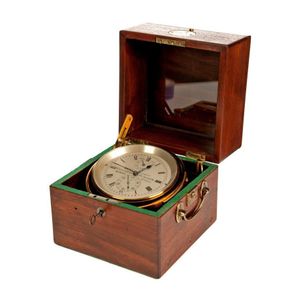19th century marine chronometer in mahogany case
You must be a subscriber, and be logged in to view price and dealer details.
Subscribe Now to view actual auction price for this item
When you subscribe, you have the option of setting the currency in which to display prices to $Au, $US, $NZ or Stg.
- Gimbal - On a ship, a gimbal is a pivoted mounting for the compass, clock, chronometer, stoves, drink holders and other equipment which keeps the item horizontal, no matter which way the vessel is leaning.
- Movement - The technical name for the workings of a clock or watch, and does not include the dial or case.
- Fusee - The fusee movement was used in clocks and pocket watches from the mid 17th century. The fusee is a cone shaped drum within the works that is linked to the barrel of the spring, usually by a length of chain.
As the mainspring loses its tension over time, the cone shaped barrel compensates for this by increasing the tension, by pulling the mainspring tighter, thus ensuring the time remains constant.
Use of the fusee in clocks was superseded by the "going barrel" in the mid 19th century and for pocket watches at the beginning of the 19th century.
The fusee continued to be used in marine chronometers until the 1970s. - Mahogany - Mahogany is a dense, close grained red-coloured timber from the West Indies and Central America. It was first imported into Europe in the the early 18th century and its use continued through the 19th century. It was popular for furniture making because of its strength, the wide boards available, the distinctive grain on some boards, termed flame mahogany and the rich warm colour of the timber when it was polished.. The "flame" was produced where a limb grew out from the trunk of the tree, and this timber was usually sliced into veneers for feature panels on doors, backs and cornices.
Some terms used to describe mahogany relate to the country from which it originally came, such as "Cuban" mahogany, "Honduras" mahogany etc. However unless the wood has been tested the names assigned are more a selling feature, rather than a true indication of the timber's origin. - Tier - One or more under-shelves of a table or cabinet.
- Thomas Earnshaw Balance Springs - Thomas Earnshaw (1749 ? 1829 )was a British clock and watch maker who was a renowned inventor and craftsman. Earnshaw is credited with standardizing the design of the marine chronometer, making it a more reliable and accurate instrument for navigation. He also developed a process for hardening the balance springs used in chronometers, which made them more durable and resistant to temperature changes.
This item has been included into following indexes:
Visually similar items

A fine 19th century two day marine Chronometer with Dent's patent staple balance and Ernshaw spring detent escapement, freesprung. The balance consists of a cross bar with U shaped bimetallic affixes to reduce the effects of temperature. Silvered dial with

An English rosewood cased two day marine chronometer, circa 1860 the silvered dial signed John Poole, maker to the Admiralty, Fenchurch St., London. no.2251, subsidiary seconds and up-down gimbal, mounted within three tier rosewood case with original ivory

Antique Lewis Woolf marine chronometer, etched in scrip on face and on ivory label to lid reads Lewis Woolf / No. 35 South Castle Street/Liverpool inset side handles, original three-tier, brass escutcheon and brass bound mahogany case, 18 cm height, 17.5 w

Chronometer by Thomas Mercer Ltd St. Albans, England, in original timber case. Supplied by Henry Browne & Son Ltd Barking (no. 19226), with Dutch shipping lable 'N.V. Observator Rotterdam' & vessel name (illegible)
